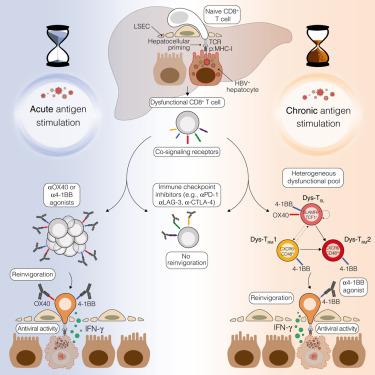Our official English website, www.x-mol.net, welcomes your feedback! (Note: you will need to create a separate account there.)
Therapeutic potential of co-signaling receptor modulation in hepatitis B
Cell ( IF 45.5 ) Pub Date : 2024-06-18 , DOI: 10.1016/j.cell.2024.05.038 Francesco Andreata 1 , Chiara Laura 2 , Micol Ravà 1 , Caroline C Krueger 1 , Xenia Ficht 1 , Keigo Kawashima 3 , Cristian G Beccaria 1 , Federica Moalli 3 , Bianca Partini 1 , Valeria Fumagalli 1 , Giulia Nosetto 1 , Pietro Di Lucia 1 , Ilaria Montali 4 , José M Garcia-Manteiga 5 , Elisa B Bono 3 , Leonardo Giustini 3 , Chiara Perucchini 3 , Valentina Venzin 3 , Serena Ranucci 3 , Donato Inverso 1 , Marco De Giovanni 3 , Marco Genua 6 , Renato Ostuni 7 , Enrico Lugli 8 , Masanori Isogawa 9 , Carlo Ferrari 10 , Carolina Boni 10 , Paola Fisicaro 4 , Luca G Guidotti 1 , Matteo Iannacone 1
Cell ( IF 45.5 ) Pub Date : 2024-06-18 , DOI: 10.1016/j.cell.2024.05.038 Francesco Andreata 1 , Chiara Laura 2 , Micol Ravà 1 , Caroline C Krueger 1 , Xenia Ficht 1 , Keigo Kawashima 3 , Cristian G Beccaria 1 , Federica Moalli 3 , Bianca Partini 1 , Valeria Fumagalli 1 , Giulia Nosetto 1 , Pietro Di Lucia 1 , Ilaria Montali 4 , José M Garcia-Manteiga 5 , Elisa B Bono 3 , Leonardo Giustini 3 , Chiara Perucchini 3 , Valentina Venzin 3 , Serena Ranucci 3 , Donato Inverso 1 , Marco De Giovanni 3 , Marco Genua 6 , Renato Ostuni 7 , Enrico Lugli 8 , Masanori Isogawa 9 , Carlo Ferrari 10 , Carolina Boni 10 , Paola Fisicaro 4 , Luca G Guidotti 1 , Matteo Iannacone 1
Affiliation

|
Reversing CD8 T cell dysfunction is crucial in treating chronic hepatitis B virus (HBV) infection, yet specific molecular targets remain unclear. Our study analyzed co-signaling receptors during hepatocellular priming and traced the trajectory and fate of dysfunctional HBV-specific CD8 T cells. Early on, these cells upregulate PD-1, CTLA-4, LAG-3, OX40, 4-1BB, and ICOS. While blocking co-inhibitory receptors had minimal effect, activating 4-1BB and OX40 converted them into antiviral effectors. Prolonged stimulation led to a self-renewing, long-lived, heterogeneous population with a unique transcriptional profile. This includes dysfunctional progenitor/stem-like (T) cells and two distinct dysfunctional tissue-resident memory (T) populations. While 4-1BB expression is ubiquitously maintained, OX40 expression is limited to T. In chronic settings, only 4-1BB stimulation conferred antiviral activity. In HBeAg chronic patients, 4-1BB activation showed the highest potential to rejuvenate dysfunctional CD8 T cells. Targeting all dysfunctional T cells, rather than only stem-like precursors, holds promise for treating chronic HBV infection.
中文翻译:

乙型肝炎共信号受体调节的治疗潜力
逆转 CD8 T 细胞功能障碍对于治疗慢性乙型肝炎病毒 (HBV) 感染至关重要,但具体的分子靶标仍不清楚。我们的研究分析了肝细胞启动过程中的协同信号受体,并追踪了功能失调的 HBV 特异性 CD8 T 细胞的轨迹和命运。早期,这些细胞上调 PD-1、CTLA-4、LAG-3、OX40、4-1BB 和 ICOS。虽然阻断共抑制受体效果甚微,但激活 4-1BB 和 OX40 会将它们转化为抗病毒效应器。长时间的刺激导致了自我更新、寿命长、具有独特转录特征的异质群体。这包括功能失调的祖细胞/干细胞样 (T) 细胞和两个不同的功能失调的组织驻留记忆 (T) 群体。虽然 4-1BB 表达无处不在,但 OX40 表达仅限于 T。在慢性环境中,只有 4-1BB 刺激才具有抗病毒活性。在 HBeAg 慢性患者中,4-1BB 激活显示出使功能失调的 CD8 T 细胞恢复活力的最高潜力。针对所有功能失调的 T 细胞,而不仅仅是干细胞样前体细胞,有望治疗慢性 HBV 感染。
更新日期:2024-06-18
中文翻译:

乙型肝炎共信号受体调节的治疗潜力
逆转 CD8 T 细胞功能障碍对于治疗慢性乙型肝炎病毒 (HBV) 感染至关重要,但具体的分子靶标仍不清楚。我们的研究分析了肝细胞启动过程中的协同信号受体,并追踪了功能失调的 HBV 特异性 CD8 T 细胞的轨迹和命运。早期,这些细胞上调 PD-1、CTLA-4、LAG-3、OX40、4-1BB 和 ICOS。虽然阻断共抑制受体效果甚微,但激活 4-1BB 和 OX40 会将它们转化为抗病毒效应器。长时间的刺激导致了自我更新、寿命长、具有独特转录特征的异质群体。这包括功能失调的祖细胞/干细胞样 (T) 细胞和两个不同的功能失调的组织驻留记忆 (T) 群体。虽然 4-1BB 表达无处不在,但 OX40 表达仅限于 T。在慢性环境中,只有 4-1BB 刺激才具有抗病毒活性。在 HBeAg 慢性患者中,4-1BB 激活显示出使功能失调的 CD8 T 细胞恢复活力的最高潜力。针对所有功能失调的 T 细胞,而不仅仅是干细胞样前体细胞,有望治疗慢性 HBV 感染。
















































 京公网安备 11010802027423号
京公网安备 11010802027423号